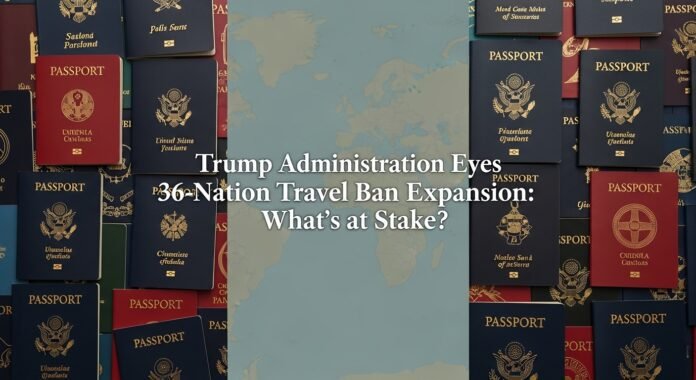Trump Administration Eyes 36-Nation Travel Ban Expansion: What’s at Stake?
A sweeping proposal could reshape U.S. immigration, spark global debate, and impact millions—here’s what you need to know.
The Trump Administration is considering a dramatic expansion of its travel ban, potentially adding 36 more countries to its restricted list. Sparked by concerns over faulty travel documentation and alarmingly high visa overstay rates, this measure could affect millions of travelers, students, and families. Critics argue the move is xenophobic and unfairly targets Muslim-majority and African nations, while supporters insist it is a necessary step for national security. This article explains the proposal, examines its impacts, and invites readers to engage in a conversation about the future of American immigration policy.
The Evolution of the Travel Ban
How Did We Get Here?
The travel ban first emerged in 2017 with Executive Order 13769 that barred entry from seven predominantly Muslim nations. Legal challenges and widespread protests forced the administration to revise its approach several times. Subsequent versions removed or added countries, reflected changing security assessments, and expanded the scope to non-Muslim-majority countries as well.
By 2020, the administration had broadened the list to include additional nations from Africa, Asia, and the Caribbean. The justification was based on rates of visa overstays, issues with fraudulent or faulty documentation, and poor cooperation with U.S. deportation procedures. With fresh internal memo details and new data on overstay statistics, the proposal now seeks to include 36 extra countries.
The New Proposal: 36 More Countries
According to the internal memo, the travel ban expansion targets countries that struggle with secure visa issuance and face difficulties in curbing visa overstays. Nations have been given a 60-day window to implement measures such as secure, machine-readable passports, and to agree to tighter repatriation policies. Failure to meet these benchmarks could result in partial or full bans affecting both immigrant and nonimmigrant visa holders.
A senior State Department official remarked, “We are constantly reevaluating policies to ensure the safety of Americans and that foreign nationals follow our laws.”
Who’s on the List—And Why?
The Countries Under Review
The 36 countries under review include a mix of nations from Africa, Asia, the Caribbean, and the Pacific. Many of these countries are either predominantly Muslim or face significant administrative challenges in issuing secure travel documents. Critics argue the focus on these regions gives the appearance of discrimination, while the administration defends the selection as based on clear security and compliance criteria.
The Benchmarks for Compliance
Countries are expected to meet rigorous standards in order to avoid travel restrictions. They must:
- Issue secure, machine-readable passports that are hard to forge
- Sign repatriation agreements and improve deportation cooperation with U.S. authorities
- Share biometric and security data with U.S. officials
- Take concrete steps to reduce visa overstays
Failure to meet these clear, non-negotiable benchmarks within 60 days could trigger a ban. This process is designed not only to enhance national security but also to press foreign governments toward stronger immigration controls.
The Human Impact
Disruption for Families and Students
The travel ban’s effects are far-reaching. Since its implementation, family reunifications have suffered dramatically; admissions for immediate relatives from banned nations dropped by as much as 67% between 2016 and 2019. International students, vital to U.S. academic and cultural exchange, also face uncertainty. In 2023, the overstay rate for F, M, and J visa holders reached 3.67%, heightening concerns for universities and colleges that rely on a diverse international student body.
An affected individual described the new restrictions as “a sudden wall—built not of bricks, but bureaucracy”—illustrating the deep personal toll such measures can take.
Economic and Academic Consequences
Universities across the nation have strongly cautioned that these travel restrictions could hamper international recruitment and academic exchanges. Businesses warn that reduced diversity in the workforce, particularly in sectors like healthcare and technology, might lead to critical skill shortages. The potential loss of international talent directly impacts the innovation and global competitiveness of U.S. institutions and industries.
The Debate: Security Concerns Versus Discrimination
Criticisms and Counterarguments
Civil rights groups and legal experts have vocally condemned the travel ban as an extension of policies that discriminate based on nationality and religion. Organizations such as the ACLU and CAIR argue that the policy unfairly singles out Muslim-majority and African nations, branding it an outdated and ideologically driven measure.
“This executive order will only build on [Trump’s] reign of terror to target people solely based on their nationality or religious beliefs,” noted Sarah Mehta of the ACLU.
Critics warn that the ban separates families, disrupts economic growth, and tarnishes America’s image as a land of opportunity. They also question the selective use of visa overstay data, arguing that it does not provide a comprehensive picture of the migration landscape.
The Administration’s Defense
In contrast, the Trump Administration maintains that the travel ban is purely about national security. Officials cite Section 212(f) of the Immigration and Nationality Act which grants the president broad authority to restrict entry to safeguard American interests. The administration also points to the Supreme Court’s decision in Trump v. Hawaii, which upheld previous iterations of the ban.
“The Trump administration will always prioritize the safety of Americans. Nations unwilling or unable to meet global identity and security standards will face consequences,” stated a White House spokesperson.
This defense emphasizes that the travel ban is not intended to target any particular religion or race but to enforce compliance with U.S. security protocols.
The Numbers: Visa Overstays and Documentation Issues
Visa overstays form a core part of the justification behind the proposed travel ban expansion. In 2023, the Department of Homeland Security reported over 676,000 visa overstays. Some countries on the proposed list demonstrate overstay rates that significantly exceed global averages. Critics argue that while the numbers may warrant attention, they do not necessarily imply that visitors from these nations pose a security threat.
In addition to visa overstays, documentation issues such as the use of outdated passport technology and fraudulent documents have contributed to concerns over border security. The administration contends that enforcing stricter standards will prompt the targeted countries to modernize their systems—a benefit for global travel integrity.
What’s Next?
Legal and Political Fallout
The proposal to add 36 countries to the travel ban list is expected to spark legal challenges and intensify debates in both national and international forums. Critics predict that any new ban could face constitutional scrutiny and undermine global diplomatic relations. Meanwhile, proponents argue that stricter immigration measures are essential in preventing potential threats and ensuring national security.
A Call to Action
As policymakers, legal experts, and citizens continue to debate this issue, it is important for readers to stay informed and take action. Whether by contacting local representatives or supporting advocacy groups working on immigrant rights, every voice matters. The future of U.S. immigration policy depends on an engaged and informed public willing to speak out on behalf of fairness and security.
The Trump Administration’s potential expansion of the travel ban to include 36 additional countries marks a critical moment in the debate over immigration policy in the United States. With national security concerns cited as justification and allegations of discrimination swirling, the policy stands at a contentious crossroads. As the discussion unfolds, it is vital for communities—to both support security measures and challenge policies that marginalize vulnerable populations. Stay informed, share your views, and join the conversation on how best to balance safety with America’s longstanding commitment to opportunity.




